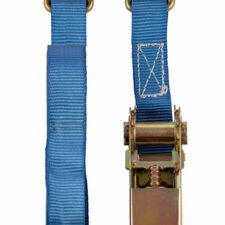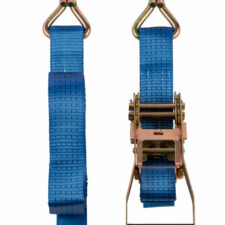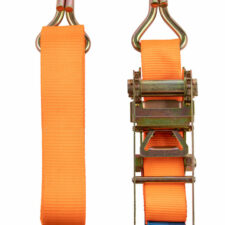What are Ratchet Lashings
Ratchet lashings are used for securing loads, typically on a lorry. They consist of webbing straps with anchoring fittings and a ratchet handle to precisely tighten the strap across the load. They come in a range of sizes with differing lashing capacities, therefore your choice will depend on the loads you wish to restrain.
Sizes of Ratchet Lashings
You will find ratchet lashings in many different sizes, differing in both width and length. The Lifting Gear Store supply the most popular sizes as standard which include 25mm, 50mm and 75mm widths all in various lengths. .
25mm Ratchet Lashings
The 25mm ratchet lashings are our smallest and are sometimes called mini ratchets. They are available in lengths from 2 metres to 10 metres as standard and have a maximum lashing capacity of 400 daN (dekanewtons of force – 1 daN = 10 Newtons or 100daN = 1 Kn – kilonewton). As an example of daN 400daN force = 400kg of load.
50mm Ratchet Lashings
The 50mm ratchet straps are our mid range and most popular. They have a lashing capacity of 2000kg and come in lengths from 2m to 15m as standard.
75mm Ratchet Lashing
The 75mm ratchet lashing is our heavy duty option with a lashing capacity of 5000kg. 6m to 10m is the standard range of lengths for this size.
Ratchet Lashing Components
All lashings come with 2 straps, one with a claw hook and open end for threading and one with a claw hook and the ratchet handle.
The webbing straps are made from quality polyester materials, thus has good UV and water resistance, so great for outdoors.
Quality steel claw hooks are used on each strap, these are used for fitting the lashing to the vehicles anchor points. The ratchet handles are attached to the shorter webbing lengths and are easy use. They incorporate a locking mechanism to ensure they stay in place.
Load Lashing Safety
There are numerous safety procedures to adhere to when securing loads, especially when they are travelling on the road. An improperly secured load can be extremely hazardous.
Make sure you are well informed of the latest load securing guidelines and regulations.
You also need to ensure your lashings and vehicle anchor points are in good condition with no faults, inspect prior to each use to be sure.







